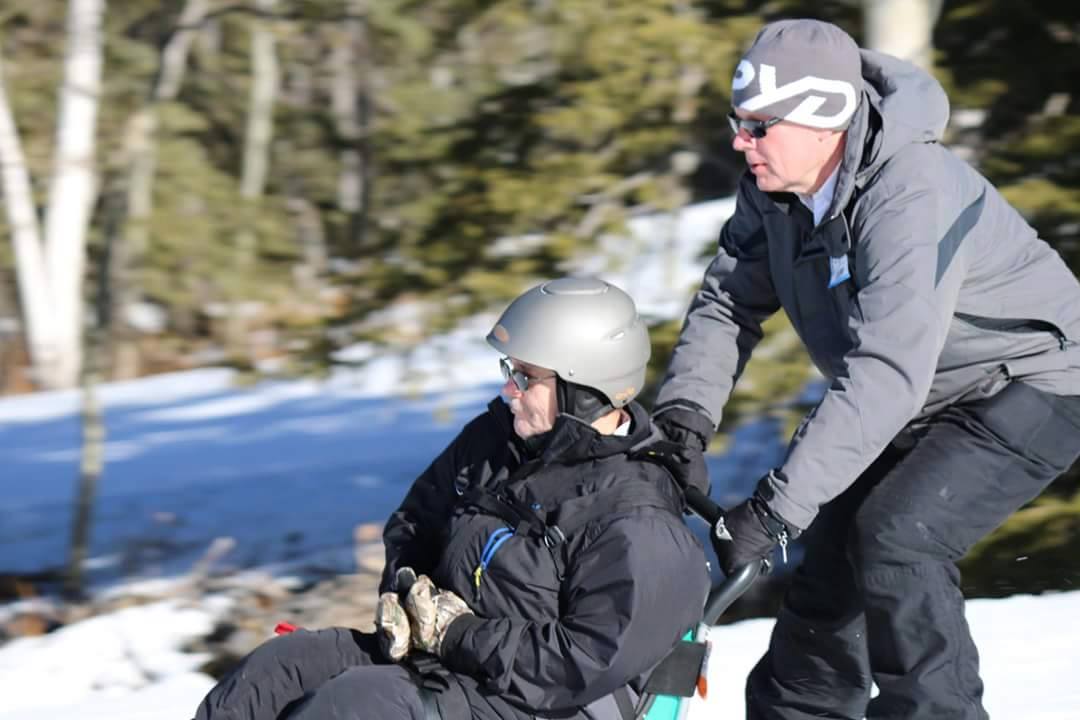
For the last six years, I have had the pleasure of serving as a downhill ski guide for blind and disabled skiers at the Black Hills Regional Ski For Light event. The photo above captures me guiding a participant down the slopes in a sitdown bi-ski.
I’m finding more and more that skiing is not the most important part of this event – what’s important, is helping people do something that they never believed they could do again. Then, once they get started, helping them do it as independently as possible.
It may be hackneyed, but the main thing I share with new guides is that our participants are “differently-abled.” What this means, is that while they may be impaired either physically or visually to the main population, they have compensating super skills in listening and physical awareness.
A great run starts on the first meeting with the participant at the loading area. Our time together begins with the sharing of names and hometowns, along with an understanding of their abilities so that I’m best able to create an experience they will enjoy. It also includes my letting them know about the sounds and sensations they will experience – from the crunch of the snow to the shape of the hill – along with information about the run itself: is it slightly tilted? Will we travel faster in one direction than another? Will the shadows change the snow as we move in and out of them?
Finally, I assure them that they are carefully belted into the lift and that great care will be taken in getting them on and off.
The best part? Hearing the laughter and joy of a great run – and the inevitable, “let’s go again.”
What Guiding Has Taught Me About Innovation
To be an effective innovator is to see the world well and understand that our view is distorted by the lens we bring to it. We all think we see well and understand the way others see it, but the truth is, what we see is greatly influenced by our background, education, and predisposition in the moment.
How can we break through these pre-judgements to see the world more clearly so that we can bring new innovations? Here are three things I learned from Guiding:
- Isolate your senses one at a time. Stop and truly listen. Touch and feel. Look at an object with different lighting, or from a different position. Take a deep breath, what do you smell? Using these techniques will allow you to gain insight, which is key to innovation. A true insight (typically defined as seeing the true nature of something) underlies all innovation.
- Paint a word picture. When you have a great experience, retell it soon afterwards – and be as descriptive as possible. Are there shadows and sounds? What color is each part of the background? What happened and in what order? This is a powerful aid to innovation since we are wired to be visual thinkers (more than 60% of our cognition is visually oriented), and when we paint word pictures, it makes communication much more vibrant.
- Practice. When I first started guiding, I thought I was doing a good job, but the truth was, my guiding was limited by my lack of observations. Being an engineer, I had no shortage of opinions and reasons, but my ability to be in the moment and really observe was very stilted. As I became more centered on the participants needs and experiences, I was able to get out of my own head and focus on the bigger context and the more important experiences that were unfolding right in front of me. This allowed me to see the role as more than technical and mechanical, and embrace the full richness for both guide and participant.
So how do we get started on these habits? One of the best tools I know of is to keep a journal with sketches and notes. Don’t just record the action points, but also the key observations that lead to them. Then, share these thoughts with a colleague – that’s how true insights begin to emerge.
Secondly, make a purposeful attempt to get outside your comfort zone. By pushing your own boundaries and becoming a learner again, you’ll find those latent skills of observation. Lastly, find something to do that serves others; it’s one of the best tools to shut down our normal “me” centricity and get to the core of who you are and what uniqueness you bring to your endeavor.
So, how well do you see? I would love to hear from you regarding how you have become a stronger innovator by being a more acute observer. Drop me an email or tweet me at @scottpropp.
Related posts you can benefit from…

